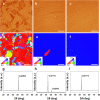Roles of Oxygen and Hydrogen in Crystal Orientation Transition of Copper Foils for High-Quality Graphene Growth
- PMID: 28367988
- PMCID: PMC5377254
- DOI: 10.1038/srep45358
Roles of Oxygen and Hydrogen in Crystal Orientation Transition of Copper Foils for High-Quality Graphene Growth
Abstract
The high-quality graphene film can be grown on single-crystal Cu substrate by seamlessly stitching the aligned graphene domains. The roles of O2 and H2 have been intensively studied in the graphene growth kinetics, including lowering the nucleation sites and tailoring the domain structures. However, how the O2 and H2 influence Cu orientations during recrystallization prior to growing graphene, still remains unclear. Here we report that the oxidation of Cu surface tends to stabilize the Cu(001) orientation while impedes the evolution of Cu(111) single domain during annealing process. The crystal orientation-controlled synthesis of aligned graphene seeds is further realized on the long-range ordered Cu(111) substrate. With decreasing the thickness of oxide layer on Cu surface by introducing H2, the Cu(001) orientation changes into Cu(111) orientation. Meanwhile, the average domain size of Cu foils is increased from 50 μm to larger than 1000 μm. The density functional theory calculations reveal that the oxygen increases the energy barrier for Cu(111) surface and makes O/Cu(001) more stable than O/Cu(111) structure. Our work can be helpful for revealing the roles of O2 and H2 in controlling the formation of Cu single-crystal substrate as well as in growing high-quality graphene films.
Conflict of interest statement
The authors declare no competing financial interests.
Figures




Similar articles
-
Oxide-assisted growth of scalable single-crystalline graphene with seamlessly stitched millimeter-sized domains on commercial copper foils.RSC Adv. 2018 Feb 26;8(16):8800-8804. doi: 10.1039/c8ra00770e. eCollection 2018 Feb 23. RSC Adv. 2018. PMID: 35539852 Free PMC article.
-
Growth of Single-Layer and Multilayer Graphene on Cu/Ni Alloy Substrates.Acc Chem Res. 2020 Apr 21;53(4):800-811. doi: 10.1021/acs.accounts.9b00643. Epub 2020 Mar 24. Acc Chem Res. 2020. PMID: 32207601
-
Toward Epitaxial Growth of Misorientation-Free Graphene on Cu(111) Foils.ACS Nano. 2022 Jan 25;16(1):285-294. doi: 10.1021/acsnano.1c06285. Epub 2021 Dec 29. ACS Nano. 2022. PMID: 34965103
-
Realizing controllable graphene nucleation by regulating the competition of hydrogen and oxygen during chemical vapor deposition heating.Phys Chem Chem Phys. 2016 Aug 24;18(34):23638-42. doi: 10.1039/c6cp03102a. Phys Chem Chem Phys. 2016. PMID: 27506467
-
Controlled Growth of Single-Crystal Graphene Films.Adv Mater. 2020 Jan;32(1):e1903266. doi: 10.1002/adma.201903266. Epub 2019 Oct 3. Adv Mater. 2020. PMID: 31583792 Review.
Cited by
-
Facile fabrication of a graphene-based chemical sensor with ultrasensitivity for nitrobenzene.RSC Adv. 2024 Mar 25;14(14):9799-9804. doi: 10.1039/d3ra08794h. eCollection 2024 Mar 20. RSC Adv. 2024. PMID: 38528921 Free PMC article.
-
Growth and Characterization of Graphene Layers on Different Kinds of Copper Surfaces.Molecules. 2022 Mar 9;27(6):1789. doi: 10.3390/molecules27061789. Molecules. 2022. PMID: 35335154 Free PMC article.
-
Oxide-assisted growth of scalable single-crystalline graphene with seamlessly stitched millimeter-sized domains on commercial copper foils.RSC Adv. 2018 Feb 26;8(16):8800-8804. doi: 10.1039/c8ra00770e. eCollection 2018 Feb 23. RSC Adv. 2018. PMID: 35539852 Free PMC article.
-
Crystallization of Copper Films on Sapphire Substrate for Large-Area Single-Crystal Graphene Growth.Nanomaterials (Basel). 2023 May 22;13(10):1694. doi: 10.3390/nano13101694. Nanomaterials (Basel). 2023. PMID: 37242110 Free PMC article.
-
Surface-Dependent Hydrogen Evolution Activity of Copper Foil.Materials (Basel). 2023 Feb 21;16(5):1777. doi: 10.3390/ma16051777. Materials (Basel). 2023. PMID: 36902893 Free PMC article.
References
-
- Li X. et al.. Large-area synthesis of high-quality and uniform graphene films on copper foils. Science. 324, 1312–1314 (2009). - PubMed
-
- Bae S. et al.. Roll-to-roll production of 30-inch graphene films for transparent electrodes. Nat. Nanotech. 5, 574–578 (2010). - PubMed
-
- Deng B. et al.. Roll-to-roll encapsulation of metal nanowires between graphene and plastic substrate for high-performance flexible transparent electrodes. Nano Lett. 15, 4206–4213 (2015). - PubMed
-
- Huang P. et al.. Grains and grain boundaries in single-layer graphene atomic patchwork quilts. Nature. 469, 389–392 (2011). - PubMed
-
- Kim K. et al.. Grain boundary mapping in polycrystalline graphene. ACS Nano. 5, 2142–2146 (2011). - PubMed
Publication types
LinkOut - more resources
Full Text Sources
Other Literature Sources

